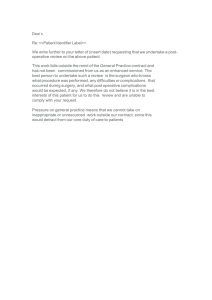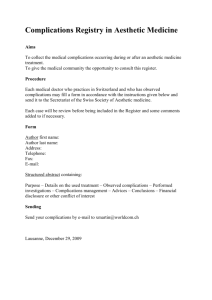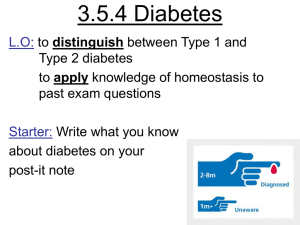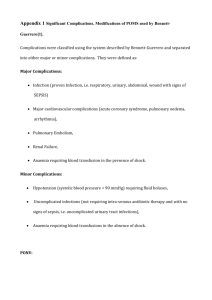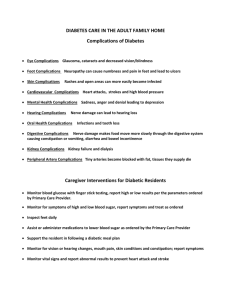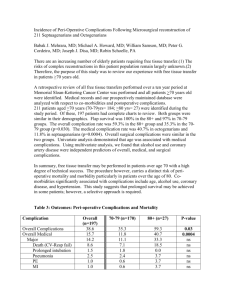Document 10677581
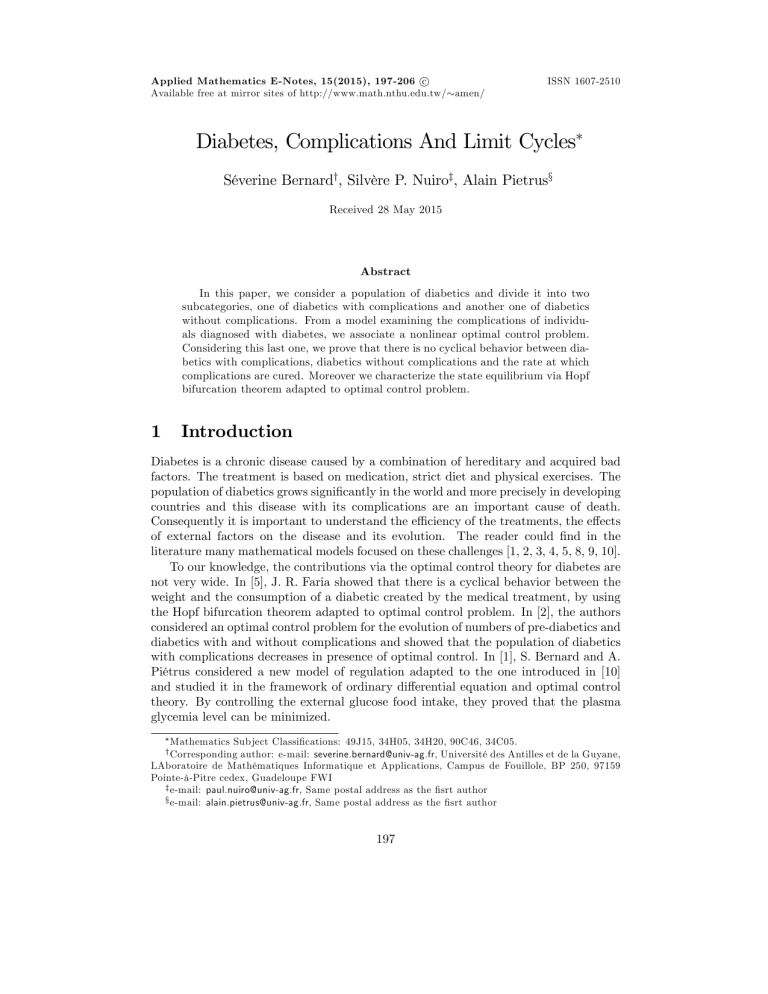
Applied Mathematics E-Notes, 15(2015), 197-206 c
Available free at mirror sites of http://www.math.nthu.edu.tw/ amen/
ISSN 1607-2510
Diabetes, Complications And Limit Cycles
Séverine Bernard
y
, Silvère P. Nuiro
z
, Alain Pietrus
x
Received 28 May 2015
Abstract
In this paper, we consider a population of diabetics and divide it into two subcategories, one of diabetics with complications and another one of diabetics without complications. From a model examining the complications of individuals diagnosed with diabetes, we associate a nonlinear optimal control problem.
Considering this last one, we prove that there is no cyclical behavior between diabetics with complications, diabetics without complications and the rate at which complications are cured. Moreover we characterize the state equilibrium via Hopf bifurcation theorem adapted to optimal control problem.
1 Introduction
Diabetes is a chronic disease caused by a combination of hereditary and acquired bad factors. The treatment is based on medication, strict diet and physical exercises. The population of diabetics grows signi…cantly in the world and more precisely in developing countries and this disease with its complications are an important cause of death.
Consequently it is important to understand the e¢ ciency of the treatments, the e¤ects of external factors on the disease and its evolution. The reader could …nd in the literature many mathematical models focused on these challenges [1, 2, 3, 4, 5, 8, 9, 10].
To our knowledge, the contributions via the optimal control theory for diabetes are not very wide. In [5], J. R. Faria showed that there is a cyclical behavior between the weight and the consumption of a diabetic created by the medical treatment, by using the Hopf bifurcation theorem adapted to optimal control problem. In [2], the authors considered an optimal control problem for the evolution of numbers of pre-diabetics and diabetics with and without complications and showed that the population of diabetics with complications decreases in presence of optimal control. In [1], S. Bernard and A.
Piétrus considered a new model of regulation adapted to the one introduced in [10] and studied it in the framework of ordinary di¤erential equation and optimal control theory. By controlling the external glucose food intake, they proved that the plasma glycemia level can be minimized.
Mathematics Sub ject Classi…cations: 49J15, 34H05, 34H20, 90C46, 34C05.
y Corresponding author: e-mail: severine.bernard@univ-ag.fr
, Université des Antilles et de la Guyane,
LAboratoire de Mathématiques Informatique et Applications, Campus de Fouillole, BP 250, 97159
Pointe-à-Pitre cedex, Guadeloupe FWI z e-mail: paul.nuiro@univ-ag.fr
, Same postal address as the …srt author x e-mail: alain.pietrus@univ-ag.fr
, Same postal address as the …srt author
197
198 Diabetes, Complications and Limit Cycles
In this work, we consider a population of diabetics, divided into two subcategories, one of diabetics with complications and another one of diabetics without complications as in [3]. From the model examining the complications of individuals diagnosed with diabetes, we associate a nonlinear optimal control problem. Considering this last one, we prove that there is no cyclical behavior between diabetics with complications, diabetics without complications and the rate at which complications are cured. Moreover, we are placed in the framework of a nonlinear optimal control problem with a scalar control and two states for which necessary conditions of an optimal control are well known
[7]. We can thus characterize the equilibrium point by using an adaptation of Hopf bifurcation theorem to optimal control models as it has been done in [6, 13, 14, 15].
Consequently, section 2 is devoted to the two dimensional nonlinear optimal control problem. From a control chosen as the rate at which complications are cured and a concave performance index chosen as a combination of the control and the two subcategories of diabetics, we show the existence of an optimal control and characterize it via the Pontryagin’s maximum principle. In section 3, we prove that there is an equilibrium state and that there is no cyclical behavior between the number of diabetics with complications, the one of diabetics without complications and the rate at which complications are cured. The equilibrium state is characterized in section 4 with the help of computations on Maple that we describe in the appendix. We …nish by some concluding remarks and perspectives.
2 The Optimal Control Problem
In this section, we are going to use some results on the optimal control theory for a model examining the complications of individuals diagnosed with diabetes. This theory is very wide and we refer the reader to [7, 11, 12] for more details about it.
We begin with the mathematical model of [3] in which we choose all the parameters depending on the time:
D 0 ( t ) = I ( ( t ) + ( t )) D ( t ) + ( t ) C ( t ) ;
C 0 ( t ) = ( t ) D ( t ) ( ( t ) + ( t ) + ( t ) + ( t )) C ( t ) ;
(1) where t is the time,
D ( : ) the number of diabetics without complications,
C ( : ) the number of diabetics with complications,
I the incidence of diabetes,
( : ) the probability of developing a complication,
( : ) the natural mortality rate,
( : ) the rate at which complications are cured,
( : ) the rate at which patients with complications become severely disabled,
Bernard et al.
199
( : ) the mortality rate due to complications.
In this work, the chosen control is u ( t ) = ( t ) , the rate at which complications are cured. Is is natural to make this choice regarding the following but other choices of control could be interesting.
THEOREM 1. For all …xed control u = , there exists one and only one maximal solution ([0 ; t m
( u )] ; D u
( : ) ; C u
( : )) of the Cauchy problem (1) with the initial conditions
D (0) = D
0
2 R , C (0) = C
0
2 R and t m
( u ) 2 R
+
[ f + 1g .
PROOF. It follows from the application of Cauchy-Lipschitz’s theorem for the problem (1) since all the functions , , , and are in L 1 ( I; R
+
) .
For a …xed discount rate r > 0 , we de…ne a concave performance index
F ( ; D; C ) = ln + ln C + D; with > 0 which will be well chosen later, and our aim is to maximize
Z
0
+ 1 exp( rt ) F ( ( t ) ; D ( t ) ; C ( t )) dt:
THEOREM 2. Let ( D
0
; C
0
) be in IR 2 such that there is a control u ( : ) satisfying (1) with the initial conditions D (0) = D
0 and C (0) = C
0
. There exists an optimal control u de…ned on [0 ; + 1 [ such that the associated trajectory ( D u
( : ) ; C u
( : )) satis…es (1), the initial conditions and which maximizes
Z
+ 1 exp( rt ) F ( ( t ) ; D ( t ) ; C ( t )) dt:
0
PROOF. We are in the framework of [7, 13] that is a nonlinear optimal control problem with a scalar control u ( t ) = ( t ) and two states D ( t ) and C ( t ) where the present value of a concave performance index F ( ; D; C ) has to be maximized. We conclude by following the gait of [13].
In order to characterize this optimal control, we are going to apply as usual the
Pontryagin’s maximum principle. We refer the reader to [7, 11, 12, 13] for more details about this principle and more precisely on the necessary conditions for an optimal control.
THEOREM 3. With previous assumptions, there exists an application P ( : ) =
( P
D
( : ) ; P
C
( : )) : [0 ; + 1 [ !
R 2 for almost all t 0 , absolutely continuous called adjoint vector, such that,
(
P 0
D
( t ) = ( r + ( t ) + ( t )) P
D
( t ) ( t ) P
C
( t ) 1 ;
P 0
C
( t ) = ( r + ( t ) + ( t ) + ( t )) P
C
( t ) ( C ( t )) 1 + ( t )( P
C
( t ) P
D
( t )) ;
200 Diabetes, Complications and Limit Cycles with the limiting transversality conditions
8
< lim t !
+ 1 exp( rt ) P
D
( t ) D ( t ) = 0 ;
: lim t !
+ 1 exp( rt ) P
C
( t ) C ( t ) = 0 :
And the optimal control , whose existence has been proved in previous theorem, is given by
8 t 0 ; ( t ) =
( t )
( P
C
( t ) P
D
( t )) C ( t )
:
PROOF. The associated Hamiltonian is de…ned from the state equations and the integrand of the objective function F ( ; D; C ) as
H ( ; D; C; P
D
; P
C
) = ln + ln C + D + P
D
[ I ( + ) D + C ]
+ P
C
[ D ( + + + ) C ] :
We just apply the Pontryagin’s maximum principle and the fact that the optimal control has to maximize the Hamiltonian with respect to u . We omit all the t in order to relieve the writing and we do it from now.
3 Existence of Equilibrium State
THEOREM 4. If = 0 , < 1 1 I and r > I (1 1 I ) 1 ; then there is an equilibrium state for the system
8
> D
0
( t ) = I ( ( t ) + ( t )) D ( t ) + ( t ) C ( t ) ;
C
0
( t ) = ( t ) D ( t ) ( ( t ) + ( t ) + ( t ) + ( t )) C ( t ) ;
P
P
0
D
0
C
( t ) = ( r + + ) P
D
( t )
( t ) = ( r + + + ) P
C
( t )
P
C
(
( t ) 1 ;
C ( t ))
1
+ ( P
C
( t ) P
D
( t )) :
PROOF. The equilibrium state ( D ; C ; P
D lowing system that we are going to solve:
8
> I ( + ) D + C = 0 ;
; P
C
) if it exists, is solution of the fol-
D ( + + + ) C = 0 ;
( r + + ) P
D
( r + + + ) P
C
P
C
C
1 = 0 ;
1 + ( P
C
P
D
) = 0 :
In order to simplify the writing, let us set = + ; and = + + ; and T = P
C
By replacing by ( T C )
1
; the use of the …rst equation gives
P
D
:
D =
IT +
T and the use of the second one gives
C = D
T
:
Bernard et al.
201
Consequently,
C =
( + IT )
T
Moreover, by using the fourth equation, we obtain
1
P
C
=
( r + ) C so
(1 ) T
P
C
=
( r + )[ IT + (
The third equation implies that
P
D
= r +
1
P
C
+ r +
: so
P
D
=
)]
:
T [ (1 ) + I ( r + )] + ( r + )(
( r + )( r + )[ IT + ( )]
Thus
T =
( r + )(1 ) T T [ (1 ) + I ( r + )]
( r + )( r + )[ IT + ( )]
)
:
( r + )(
We obtain
T ( r + )( r + )[ IT + (
= ( r + )(1 ) T T [ (1
)]
) + I ( r + )] ( r + )(
)
:
) ; that is
I
+
( r + )(
(1 r + ) T
2
+ [ ( )( r + )( r + ) ( r + )(1
) + I ( r + ) T ] + ( r + )( ) = 0 :
)
But = 0 that is = so
T =
(1 ) r I ( r + )
;
I ( r + )( r + ) since and T are non equals to zero. Consequently
P
C
=
(1 )
( r + ) I
, P
D
=
(1 ) + ( r + ) I
;
( r + )( r + ) I
C =
I
, and D =
I
+
I ( r + )( r + )
[ (1 ) r I ( r + )]
:
It follows that
=
(1
( r + )( r + )
) r I ( r + ) and > 0 if and only if r [ (1 ) I ] > I . At this stage, we have to discuss about possible values of and r to ensure the existence of equilibrium state.
202 Diabetes, Complications and Limit Cycles
If > 1 then < 0 , if = 1 then < 0 , if < 1 1 I then > 0 if and only if r > I
(1 ) I
, if 1
1
I < < 1 then < 0 .
There is only the third case which leads us to conclude, since is a rate so has to be non negative.
4 Stability Analysis
In this part we are going to classify the equilibrium state de…ned in the previous section.
THEOREM 5. There is no limit cycle between the number of diabetics with complications, the one of diabetics without complications and the rate at which complications are cured.
PROOF. Let us de…ne the Jacobian by
0
J =
@D 0 =@D @D 0 =@C @D 0 =@P
D
@C 0 =@D @C 0 =@C @C 0
@P
@P
0
D
0
C
=@D @P
=@D @P
0
D
0
C
=@C @P
=@C @P
0
D
0
C
=@P
D
=@P
D
=@P
D and the term K by
@D 0
@C 0
=@P
C
=@P
C
@P
@P
0
D
0
C
=@P
C
=@P
C
1
K =
@D
0
@P
0
D
=@D @D
0
=@D @P
0
D
=@P
D
=@P
D
+
@C
0
@P
0
C
=@C @C
=@C @P
0
0
C
=@P
C
=@P
C
+2
@D
0
@P
0
D
=@C @D
0
=@C @P
0
D
=@P
C
=@P
C
In order to study the existence of a limit cycle, it is necessary to know the sign of the determinant of the Jacobian J and of the term K calculated at the state equilibrium point. For our problem, we have
J =
0
( + )
0
0
( +
C
0
+
2
+ ) r +
0
0
+ r + +
0
0
+ +
1
: and
K =
( + )
0
0 r + +
Consequently,
+
( +
C
+
2
+ ) 0 r + + + +
+2
0
0
: det J = [( + )( + + + ) ] r + + r + + + +
;
Bernard et al.
203 that is det J = [( + )( + + + ) and
] [( r + + )( r + + + + ) ] det J = [ ( + + ) + ( + + + )] [( r + )( r + + + + )
+ ( r + + + )] ; which implies that det J 0 . Moreover,
K = ( + )( r + + ) ( + + + )( r + + + + ) 2 ; that is K 0 . Since det J 0 and K 0 , we can say that there is no limit cycle between diabetics with complications, diabetics without complications and the rate at which complications are cured.
Let us notice that this result occurs without using the equilibrium state and does not depend on the form of F .
THEOREM 6. The equilibrium state de…ned in previous section is a saddle point.
PROOF. In order to classify the state equilibrium, we have to know the sign of
Q = det( J )
1
2
K 2 . Because of the complications of the calculus, we use Maple. We write Q as a polynomial function of degree 4 in and evaluate the coe¢ cients of the powers of to note that there are negatives, which allows us to conclude that Q is negative, since is positive. The reader can …nd the di¤erent orders in the following appendix. Consequently, we can say that one has a saddle point stability, real roots, two are negative and two are positive, and local monotonicity, according to the classi…cation of equilibria from det( J ) and K of [6].
5 Concluding Remarks
In this paper, we proved that by controlling the rate at which complications are cured, we can maximize the number of diabetics with complications which are cured and those without complications. Moreover we showed that the evolution of complications of diabetics does not stabilize around the equilibrium state which is in fact a saddle point. All these results seem to conform to the reality. For the sequel, it will be interesting to see the in‡uence of physical exercises, consumption and treatment on the number of diabetics with complications. For this, the …rst challenge would be to introduce these parameters in the models and the second one would be to control them in order to reduce the number of diabetics with complications.
6 Appendix
For the sake of simplicity, we have set d := , g := , l := , m := , n := et x := r in the Maple command lines.
204 Diabetes, Complications and Limit Cycles
First, we introduce, the formulas of det( J ) and K by typing:
> det ( J ) := (( x + m ) ( x + g + m + n + d ) + l ( x + m + n + d )) ( l ( m + n + d
+ m ( g + m + n + d ));
> K := ( l + m ) ( x + l + m ) ( g + m + n + d ) ( x + g + m + n + d ) 2 g l ;
After, we evaluate Q = det(
> Q := evala ( det ( J ) K
J
2
= 4 );
)
1
2
K 2 by typing
Our goal is to develop the polynomial function Q as a power series of the variable g:
The polynomial function Q is of fourth degree and clearly, the coe¢ cient of g
4 is
1
4
:
That is why we introduce
> coe _ g4 := 1 = 4 ;
In order to determine the coe¢ cient of g 3 , we use the following command line:
> isolate ( Q coe _ g4 g^4 ; g^3 ); which leads us to set
> coe _ g3 := m n d l 1 = 2 x ;
With the same method, we determine the coe¢ cient of g 2 , by using the following command line:
> isolate ( evala ( Q coe _ g4 g^4 coe _ g3 g^3 ) ; g^2 ); which leads us to set
> coe _ g2 := 3 = 2 x n 3 = 2 l x 2 l n 2 l d 3 = 2 x d x m
3 m n 3 n d 3 m d 3 l m 3 = 2 l^2 m^2 1 = 4 x^2 3 = 2 n^2
3 = 2 d^2 ;
Still in the same way, we determine the coe¢ cient of g , using this command line:
> isolate ( evala ( Q coe _ g4 g^4 coe _ g3 g^3 coe _ g2 g^2 ) ; g ); which leads us to set the command line
> coe _ g1 := 2 x m n x l n 2 m l d 2 x l m 6 m n d
2 m l n x l d 2 x m d l^3 n^3 d^3 3 = 2 l^2 x 1 = 2 x^2 d
3 l^2 m 3 m n^2 1 = 2 l x^2 l^2 d 3 = 2 x d^2 1 = 2 x^2 n
2 m^2 l 3 = 2 x n^2 2 m^2 n n^2 l d^2 l 3 n^2 d
3 n d^2 3 m d^2 2 m^2 d l^2 n 3 x n d 2 n d l ;
Finally, we calculate the coe¢ cient of zero order of Q (in the expansion of Q as a power series of the variable g ) with the command line
> coe _ g0 := evala ( Q coe _ g4 g^4 coe _ g3 g^3 coe _ g2 g^2 coe _ g1 g );
To …nd the sign of coe _ g0 , we expand it as a second order power series of variable x: Using the following sequence of command
> isolate ( evala ( coe _ g0 ) ; x^2 );
> simplify ( 1 = 2 l n + 1 = 2 l d 1 = 2 n d 1 = 4 l^2 1 = 4 n^2 1 = 4 d^2
+( l n d ) ^2 = 4 ); leads us to set
> coe _ g0 _ x2 := ( l n d ) ^2 = 4 ; as the coe¢ cient of x 2 : By the same method as before, we are able to set the command line
> coe _ g0 _ x1 := ( l^2 ( n + d ) ^2 ) ( l ( n + d )) = 2 m ( l n d ) ^2 ; as the coe¢ cient of x; and
> coe _ g0 _ x0 := ( l^2 ( n + d ) ^2 ) ^2 = 4 ( m^2 ) ( l n d ) ^2 m ( l^2 ( n + d ) ^2 )
Bernard et al.
205
( l n d ); as the constant coe¢ cient with respect to the variable x:
Using the fact that all the parameters are nonnegative numbers, one can see that all the coe¢ cients of the previous expansion of Q are non positive numbers. This leads us to conclude that Q 0 :
References
[1] S. Bernard and A. Piétrus, Optimal glucose modelling for diabetes, e-Journal of the Caribbean Academy of Sciences, 8(2015).
[2] A. Boutayeb, W. Boutayeb and M. Lamlili, Optimal control approach to the dynamics of population of diabetics, Applied Math. Sciences, 8(2014), 2773–2782.
[3] A. Boutayeb, A. Chetouani, A. Achouyab and E. H. Twizell, A non-linear population model of diabetes mellitus, J. Appl. Math. Computing, 21(2006), 127–139.
[4] A. De Gaetano, T. Hardy, B. Beck, E. Abu-Raddad, P. Palumbo, J. Bue-Valleskey and N. Porksen, Mathematical models of diabetes progression, Am. J. Physiol.
Endocrinol. Metab., 295(2008), E1462–E1479.
[5] J. R. Faria, Limit cycles in an optimal control problem of diabetes, Appl. Math.
Lett., 16(2003), 127–130.
[6] G. Feichtinger, A. Novak and F. Wirl, Limit cycles in intertemporal adjustment models, J. Econom. Dynam. Control, 18(1994), 353–380.
[7] D. Grass, J. P. Caulkins, G. Feichtinger, G. Tragler and D. A. Behrens, Optimal
Control of Nonlinear Processes. With applications in drugs, corruption, and terror.
Springer-Verlag, Berlin, 2008.
[8] J. Li and J. D. Johnson, Mathematical models of subcutaneous injection of insulin analogues: A mini-review, Discret. Cont. Dyn. Syst. Ser. B, 12(2009), 401–414.
[9] A. Makroglou, J. Li and Y. Kuang, Mathematical models and software tools for the glucose-insulin regulatory system and diabetes: an overview, Appl. Num. Math.,
56(2006), 559–573.
[10] M. Meilûnas, On the blood glucose dynamics modelling, Math. Model. Anal.,
3(1998), 136–139.
[11] L. Pontryagin, V. Boltyanski, R. Gamkrelidze and E. Michtchenko, Théorie Math-
ématique Des Processus Optimaux. (French) Traduit du russe par Djilali Embarek.
Éitions Mir, Moscow, 1974. 317 pp. 49–01.
[12] E. Trélat, Contrôle optimal: théorie et applications, Vuibert (2008).
[13] F. Wirl, Cyclical strategies in two-dimensional optimal control models: necessary conditions and existence, Ann. Oper. Res., 37(1992), 345–356.
206 Diabetes, Complications and Limit Cycles
[14] F. Wirl, Pathways to Hopf bifurcations in dynamic continuous-time optimization problems, J. Optim. Theory Appl., 91(1996), 299–320.
[15] F. Wirl and G. Feichtinger, Modelling social dynamics (of obesity) and thresholds,
Games, 1(2010), 395–414.
